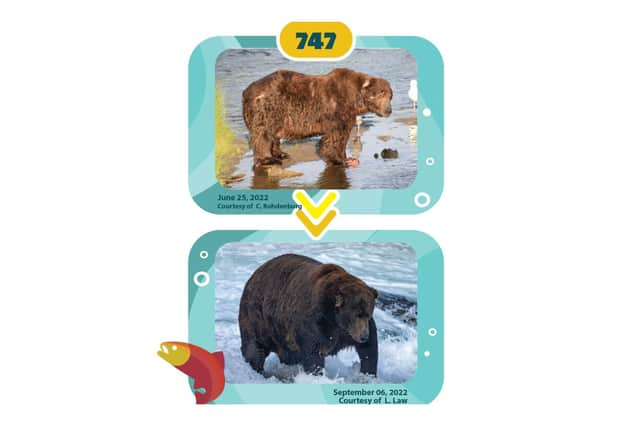Fat Bear Week 2023: What is the annual competition, when does it end, who made the final and how to vote?


For a week a year, live footage of the bears is streamed over the internet, with tens of thousands of wildlife enthusiasts voting fo the fattest bear.
It was founded by former park ranger Mike Fitz in 2014, who came up with the idea after noting the interest in online livestreams of the bears feeding at the river.
Here’s everything you need to know.
What is Fat Bear Week?
Advertisement
Hide AdAdvertisement
Hide AdPut simply, it’s a fun interactive event to choose the fattest bear of the year.
Some of the largest brown bears on Earth make their home at Brooks River in Katmai National Park, Alaska.
Brown bears need to get fat to survive the colder months and Fat Bear Week is an annual tournament celebrating their success in preparation for winter hibernation.
Originally it took place over a single day, but it has proved so popular that in now takes in an entire week of ursine gluttony.
It is a single elimination tournament and for each match-up the bear with the most votes advances to the next round.
The competition has just started, with 12 bears in the running.
Who is in the final?
Bear 747 was the 2022 Fat Bear Week champion - retaking the title he first took in 2020 and is in the running once again.
He is a very large adult male with a blocky muzzle and a floppy right ear. When 747 was first identified in 2004, he was a relatively young bear, only a few years old and unable to compete with larger bears for the most preferred fishing locations. Since then, he has become one of the largest brown bears on Earth, perhaps weighing as much as 1,400 pounds (636 kg).
Advertisement
Hide AdAdvertisement
Hide AdHe is a skilled and efficient angler who keeps his status by sheer size alone. Most bears recognize they cannot compete with him physically and they yield space upon his approach. He shows that skill and size influence success in the bear world.
Taking on Bear 747 in this year’s competition are:
Bear 32: Chunk
Bear: 128 Grazer
Bear 151: Walker
Bear 164
Bear 284
Bear 402
Bear 428
Bear 435: Holly
Bear 480: Otis
Bear 901
Bear 806: Jr.
How to vote?
You can view the latest video of the finalists, ‘before and after’ pictures of the bears, and vote on the website here.
The results will be known in the UK on the morning of Wednesday, October 12.
What bear should get your vote?
According to organisers, your Fat Bear Week vote can be based on many factors.
You may want to consider the tremendous growth spurts experienced by younger bears. Subadult (teenage) bears and cubs, for example, grow proportionally more each year than even the biggest adults.
Perhaps you want to weigh your vote toward bears with extenuating circumstances such as a mother’s cost of raising cubs or the additional challenges that older bears face as they age.
A mother bear's ability to gain weight is harder compared to other bears because she must provide for herself and the welfare of her cubs.
An older bear can have difficulty finding access to its preferred fishing spots due to competition with larger and younger bears. You can also vote for the bear you think is the simply the largest and fattest.
In short, Fat Bear Week is a subjective competition.
Why are fat bears important?
Advertisement
Hide AdAdvertisement
Hide AdAccording to the competition website, Katmai’s brown bears are at their fattest in late summer and early fall. It is the end-product of their summer-long effort to satisfy their profound hunger and prepare for winter hibernation. During hibernation, bears do not eat or drink and can lose one-third of their body weight. Their winter survival depends on accumulating ample fat reserves before entering the den.
To get fat, bears gorge on the richest and most easily obtainable foods they can find. In Katmai National Park, that most often means salmon. Dozens of bears gather at Brooks River to feast on salmon from late June until mid October. Perhaps no other river on Earth offers bears the chance to feed on salmon for so long.
Fat bears exemplify the richness of Katmai National Park and Bristol Bay, Alaska, a wild region that is home to more brown bears than people and the largest, healthiest runs of sockeye salmon left on the planet.
Read more:
Comments
Want to join the conversation? Please or to comment on this article.